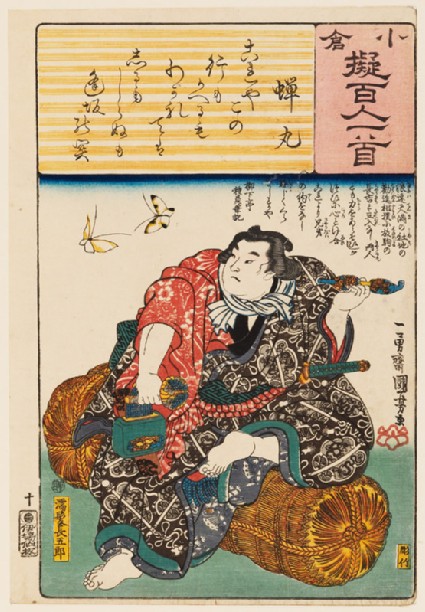Browse: 10610 objects
- Reference URL
Actions
Semimaru
-
Description
This scene from the kabuki play ‘The Two Butterflies’ depicts the distinguished sumo wrestler, Chōgorō, sitting on a rice-bale. Chōgorō had deliberately lost a match against an amateur wrestler, Chōkichi, in order to procure a popular geisha, admired by both their patrons, for his master. Chōkichi is angry when he discovers what has happened, but eventually the two wrestlers are reconciled.
The sumo bout took place in Osaka and the poem above the image concerns travellers passing through Osaka.
-
Details
- Series
- Take-offs Based on the Ogura Version of the ‘One Hundred Poems by One Hundred Poets’
- Associated place
- Date
- 1845 - 1847
- Artist/maker
-
Utagawa Kuniyoshi (1797 - 1861) (designer)Yokogawa Takejirō (active c. 1852) (block cutter)Semimaru (active 9th century AD) (author)
- Associated people
-
Ibaya Senzaburō (active c. 1820s - c. 1870s) (publisher)Kinugasa Fusajirō (active c. 1843 - 1853) (censor)
- Material and technique
- nishiki-e (multi-block) woodblock print, with bokashi (tonal gradation)
- Dimensions
-
mount 55.5 x 40.1 cm (height x width)
print 35.2 x 24.2 cm (height x width)
- Material index
- Technique index
- Object type index
- No. of items
- 1
- Credit line
- Presented by George Grigs, Miss Elizabeth Grigs, and Miss Susan Messer, in memory of Derick Grigs, 1971.
- Accession no.
- EA1971.123
Glossary
nishiki-e
-
nishiki-e
Nishiki-e literally means 'brocade pictures' and refers to multi-coloured woodblock prints.
Location
-
- currently in research collection
Objects are sometimes moved to a different location. Our object location data is usually updated on a monthly basis. Contact the Jameel Study Centre if you are planning to visit the museum to see a particular object on display, or would like to arrange an appointment to see an object in our reserve collections.
© 2013 University of Oxford - Ashmolean Museum

